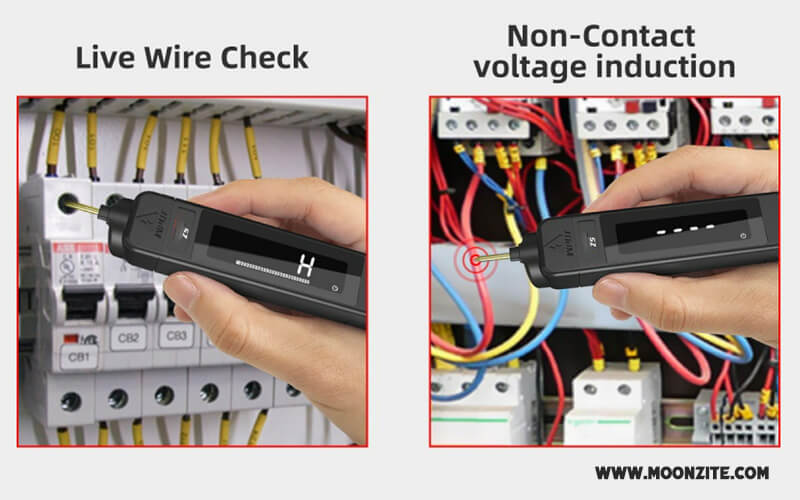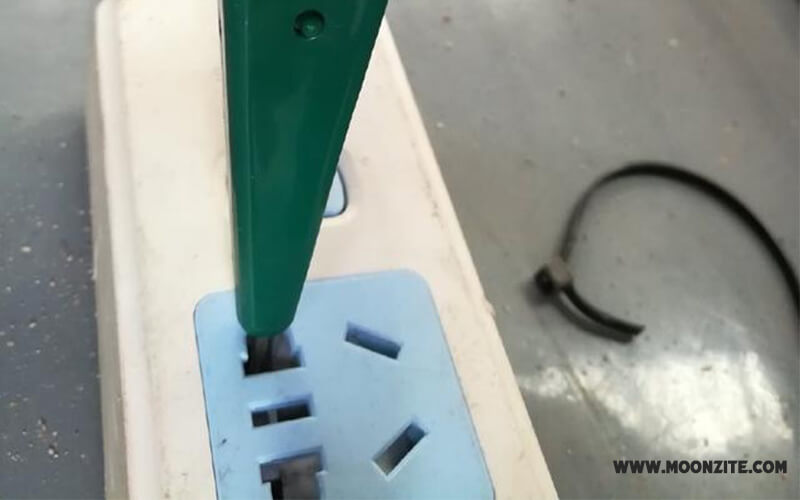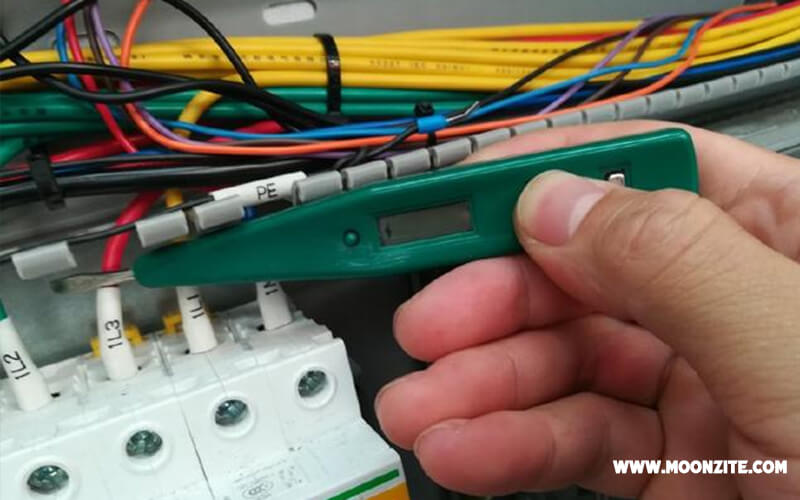What is a Voltage Tester Pen and How Does It Work?

Working with any type of electrical wiring can be a dangerous endeavor, but using the right tools is essential to ensure safety. Voltage tester pens are one of those must-have tools for anyone dealing with electrical wiring. This blog post will explain the basics of voltage tester pens and how they can help you safely evaluate your setup.
1. What is a voltage tester pen?
A voltage tester pen is a device used to detect the presence of an electrical current. The device usually consists of two electrodes connected to a handle, which can be touched with one hand while the other end is attached to metal contacts on the surface being tested. When an electrical current is present between two points, it will cause a light or sound indicator on the pen tip to activate, alerting you that there is voltage present.
Voltage testers, also known as test lights, are essential tools for electricians and other professionals who work with electricity. They allow the user to safely test electrical items without coming into contact with live wires or surfaces. By producing an auditory or visual signal when voltage is detected, they make it easy to identify the presence of voltage in wires, outlets, circuit breakers, lighting fixtures, and more. Capacitive coupling technology enables a voltage to be detected from a safe distance so that operators can avoid dangerous electric shocks.
2. Types of voltage tester pen
As a device used to test the voltage of electrical circuits. It is important to select the right type of voltage tester pen for your specific needs. There are four main types; non-contact, neon, digital, analog, and needle current testers.
Non-contact voltage tester
A non-contact voltage tester, also known as an inductance tester, is one of the safest and simplest tests to use. It allows users to test the voltage in cables or other devices without having to touch the surface or a portion of the equipment being tested. Just hold the tester's tip close to the wire and get a reading on its screen. This simple but powerful tool can be used by experienced professionals as well as do-it-yourself homeowners.
Neon voltage tester
A neon voltage tester is a small device that can tell you if there is voltage in a circuit. It features two metal probes connected to short wire leads and contains a neon light inside. However, it cannot display the range of voltage, so additional testing with wire probes must be done to determine the exact amount.
Solenoid voltage tester
A solenoid voltage tester also known as a multi-function tester, it is used to test both analog and digital voltages and polarities. It contains two wires and a probe that extends from the bottom of the tester for easy testing. With this tool, electricians can easily diagnose any electrical faults quickly and accurately.
Digital Voltage Tester
The Digital Voltage Tester is a handy tool that provides an easy and efficient way to detect faults or determine whether technical devices are operating normally. This tool can identify overloads, interference signals, and other potential sources of malfunction without necessitating physical interaction. It is a must-have device for anyone working with electronics.

3. How Does a Voltage Tester Pen Work?
Using a non-contact voltage tester is an easy and safe way to check if the power is on. All you need to do is touch the tester's tip to a wire or place it on the faceplate of a shorter plug hole. Most testers will light up or make a sound when voltage is detected, making it easy for you to know whether there's electricity running through your outlet.
There are 2 main ways to use a voltage tester.
Direct Measurement
The direct measurement method is an accurate way to measure electrical charge. The metal probe of the test pen must come into contact with the object being tested and then the direct measurement button (DIRECT) should be pressed and held. If the object is electrically charged, an indicator light on the test pen will illuminate and display a voltage value between 12v, 36v, 55v, 110v, or 220v. This will provide the user with a precise reading of the electric charge on the object being tested.
Therefore, using an electric pen to test for voltage should always be accompanied by further investigation and examination.

Inductive Measurement
Inductive measurement is a non-contact method of determining whether an object is charged. Voltage sensing is used to make this assessment, which means no direct contact is made between the test pen probe and the object. This method of measurement provides accurate results without risking damage to the object being measured.
The test pen display will indicate a voltage symbol when the wire is energized. If the disconnection indicator goes out, this symbol will disappear, indicating a disconnection at the current position. Using an inductive measurement method, it is possible to pinpoint where insulation wire has become disconnected and also to determine whether it is an insulation wire or neutral wire.

Before using a non-contact voltage tester, be sure to read and follow all safety cautions and instructions provided. It's important to note that there may be differences in operation between individual models.
4. Functions of Voltage Tester Pen
An electric test pen is an essential electrical tool and can be used to measure the presence of voltage in a line. It also has many other functions as follow:
Function 1: Measuring the Presence of Voltage in the Line
The voltage Tester Pen is a useful tool for measuring the presence of voltage in a line. When you touch the conductor with the tip of the pen, if it lights up, it means that there is voltage present. However, this does not necessarily mean that the circuit is in its normal state - a faulty zero wire can also cause it to light up. It's important to note that you cannot just rely on the light or lack of light from the pen alone to determine whether or not there is an issue with the circuit.
Function 2: Measure the phase lines of circuits
The Voltage Tester Pen has a great function that allows you to measure the phase lines of circuits easily and accurately. To use it, simply hold a pencil in each hand and stand on an insulated object. Touch both pens to two wires at the same time; if the brightness of the two pens is lower, then the two lines are in phase (both phase lines), and if it’s brighter, then one line is in phase (one phase line) and one is neutral. This way, you can quickly screen out three-phase circuits from single-phase circuits.
Function 3: Distinguishing between AC and DC power
The Voltage Tester Pen can be used to distinguish between alternating current (AC) and direct current (DC) power. It is significantly brighter when measuring AC than DC, and the neon tube glows differently depending on whether AC or DC is being measured - with AC, the entire tube lights up, while with DC only one end glows. This makes it much easier to distinguish between different types of power quickly and accurately.
Function 4: Measuring the positive and negative terminals of a direct current
When measuring the positive and negative terminals of a direct current, you can determine which is which by the position of the neon tube that illuminates. When measuring the positive terminal of the power supply, it will be the end closest to the tip of your pen that glows. On the other hand, when measuring for a negative terminal, it will be at the end away from your pen's tip that glows.
5. Safety Tips When Using a Voltage Tester Pen
Safety should always be your first concern when using a voltage tester pen. Here we have some tips for you.
● Before using an electrical tester, make sure to read and understand the instructions and documentation that comes with it. This will help you avoid potential safety risks associated with using the wrong type of tester or incorrect settings. Additionally, taking time to fully understand its capabilities will help you get more use out of your tester.
● It's important to choose one that is of good quality, easy to read and has long insulated test leads. This will ensure you can safely and accurately measure the electrical current in your environment.
● When using any type of voltage tester, it is essential to take the utmost care. If you come into contact with either lead while your body is grounded or if any part of your flesh touches the circuit, you could suffer a severe electrical shock! Therefore, be sure to use appropriate protective gear and disconnect all power sources before testing.
● For the best results and safety, all electrical projects should be performed by a licensed electrical contractor or a certified electrician. Having the right professionals handle your work ensures that you get the highest quality results, free from potential hazards and other risks associated with working on electrical systems.
● Home projects and electrical construction require taking safety precautions for personal protection and the environment. Before beginning any project, it is important to read, understand, and follow all instructions relating to the tools, materials, and components being used. This will help ensure that you are prepared to work safely and efficiently.
● Electric projects should always be done with care, as mistakes can potentially lead to injury or damage. It is important to assess the person's level of experience and access to tools and wiring before beginning the project. This will help ensure that each step of the process is done correctly and with safety in mind.
● Safety is paramount when working with electrical circuits. Before working on any wiring, it is important to positively identify the circuit, turn it off and tag it with a warning note. This is especially important when working on electric panels as there are arc flash hazards and the possibility of receiving an electric shock.
● Modifying or adding electrical circuits should be done according to local and national electrical codes. A permit and inspection should be obtained before beginning any such work to ensure safety and compliance.
Safety Checklist
Before Working with Electrical Wiring: #1. Test the Circuit Always use a good quality tester. #2. Positively Identify the Circuit Breaker or Power Source Identify and label the circuit power source, circuit breaker or fuse. #3. Turn the Circuit Off Shut the circuit off before beginning any work. #4. Test the Circuit Again Test The Circuit Again to Make Sure It Is OFF. #5. Post a Note at the Panel or Power Source Advise Others that you are working on the circuit wiring. Use Lock Out-Tag Out and Label Off Methods and Devices Whenever Possible. Personal Safety and Protection
■ A Hard Hat or Head Protection ■ Insulated Work Boots ■ Insulated Electrical Hand Tools ■ Insulated Power Tools ■ Approved Extension Cords and GFCI Protected Outlets ■ Drop Light or Flash Light ■ Overalls or Protective Clothing ■ Safety Glasses Eye Protection ■ Dust Mask ■ Ear Protection ■ Work Gloves ■ Non-Conductive Ladder
IMPORTANT: Each project should be assessed for the level of safety and personal protection that is required. Take all necessary provisions for protection against the hazards relating to Arc Flash.
Conclusion: A voltage tester pen is an essential tool for electricians and DIYers alike, providing quick and easy feedback on whether or not there is electricity in an outlet or wire without the need to strip insulation. With the right knowledge and safety precautions, it can be a very helpful tool when working with electricity.

Leave a Comment